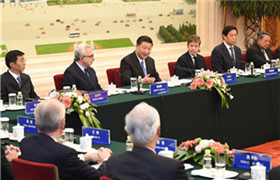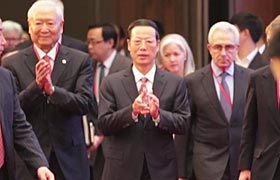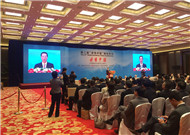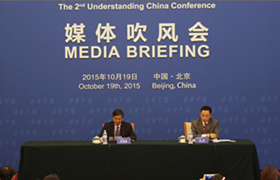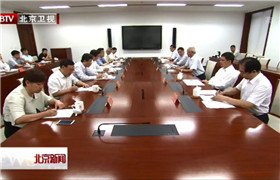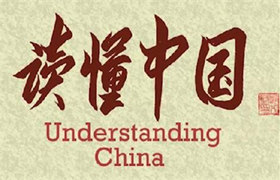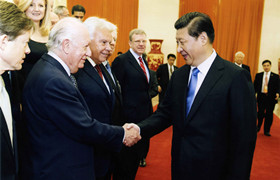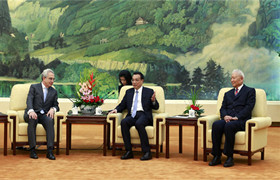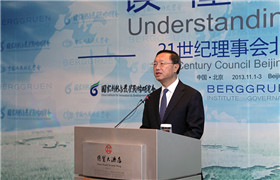- HOME--> Understanding China International Conference
-
An Outlook to China's Orientation from the Overview of Economic Globalization in the Second Decade of the 21st Century
Source:CIIDS
Zheng Bijian
Your Excellency Mr. Zedillo, Ladies and Gentlemen, and Friends:
The 21st Century Council Beijing Conference is being held on the eve of the Third Plenary Session of the 18th Central Committee of the CPC, which is to receive worldwide attention. What a happy coincidence this is! Since the theme of the conference is “Understanding China”, the topic of my remarks is “Great Changes, New Awakening, and Polarity—China’s Direction in the Second Decade of the 21st Century from the Perspective of the History of Economic Globalization”.
All of my thinking over the years boils down to the six-character concept of “great changes, new awakening”. Specifically, I refer to great changes and new awakening in China under the theme of China’s peaceful rise and to great changes and new awakening in the world under the theme of peaceful development of the world. From the perspective of the development of China and the world in modern history, these great changes and new awakening represent an unprecedented, magnificent process. Within China, the process came underway starting from the convening of the Third Plenary Session of 11th Central Committee of the CPC in 1978. Worldwide, it was set in motion in the 1970s after the Vietnam War came to an end. Enormous changes have taken place both in China and worldwide over the period of less than 40 years since then, and such changes are expected to continue unabated. It may not be an overstatement to say that the best days of these changes are yet to come.
To make my points clear, please allow me to review some history. What history is it? I will look at the road that the Chinese people have traversed in the context of the three rounds of economic globalization in modern history.
Let’s start by referring to the two historical tasks or ideals of the several generations of Chinese people since the Opium War in the mid-19th century. First, they were to win national independence and liberation of the people; second, they were to achieve national prosperity and common affluence of the people. Simply, they were to save the nation from being subjugated and ensure its survival and rejuvenation. It was because the Chinese nation had gone through untold misfortunes since modern history that accomplishing these two tasks was the biggest test for the Chinese nation, including the various classes and the parties and their leaders. Hence they were the loftiest goals the Chinese people had striven for indefatigably one generation after another.
In 1956, Chairman Mao said, “If after working at it for fifty or sixty years you are still unable to overtake the United States, what a sorry figure you will cut! You should be rid of the face of the earth.”[i] Today, we might say, “If we are unable to get past the ‘middle-income’ trap, achieve industrialization and hence modernization, and fulfill great renaissance of the Chinese nation in the first half of the 21st century, we will face the danger of being rid of the face of the earth, sooner or later, in the global wave of the Third Industrial Revolution.” Therefore, the concepts of “saving the Chinese nation from being subjugated” and “rejuvenation and development” that had been established amid internal disturbances and foreign aggression for nearly two centuries are logically the fundamental historical starting point for the people in today’s China to achieve the China Dream.
Over the past 173 years since the Opium War, China has undergone tremendous changes, and so has the world. These changes are closely interconnected. What underlies these historical interconnections? Simply put, it is the fact that China has undergone three major transformations in tandem with the three rounds of economic globalization worldwide.
When the first round of economic globalization started around 1750, the Qing Dynasty was in a course of decline and Emperor Qianlong was indulging in his dream of “heavenly empire”. The Industrial Revolution took place in 1750 in the United Kingdom and it was accomplished in 1840 with the completion of railway networks in the country. It was in the year 1840 that the UK launched the Opium War against China, plunging it into a semi-colonial country. Thus, the year was a watershed year for both countries, marking the beginning of two polarized fates. Thereafter, the Chinese embarked on the road of saving the nation from subjugation and seeking national rejuvenation and development. As a result, wave after wave of the Old Democratic Revolution surged until Sun Yat-Sen, pioneer of China’s democratic revolution, overthrew the Qing Dynasty and put an end to feudal monarchy in China and proclaimed the Republic of China. Sun Yat-Sen had raised the resounding slogan of “rejuvenating China” and initiated a national democratic revolution in its true sense. However, the Xinhai Revolution of 1911 did not change the innate nature of Old China, and the national power continued to decline. On the whole, during the historical process of the first round of economic globalization from mid-18th century till the end of the 19th century, the Chinese were not able to seize the opportunities as they arose; rather, they were subjugated and became the biggest victim of economic globalization and capital colonialism.
That’s the fate of the Chinese nation amid the first round of economic globalization.
What about the second round of economic globalization? From the end of the 19th century to the beginning of the 20th century, Western capitalist countries entered the stage of imperialism, that is, political and economic dominance. Started as wars by the rising imperialist powers to re-divide the world, the two world wars interrupted or reversed the second round of economic globalization. At the same time, these wars led to revolutions, that is, the Russian Revolution of 1917 and subsequently the great revolution of the Chinese people led by Mao Zedong and the Chinese Communist Party of China and the founding of the People’s Republic of China. The Chinese people embraced the opportunities resulting from the interruption of the second round of economic globalization by engaging in a revolution and achieving national independence and liberation of the people. Thus, the nation set forth on the road to achieving the ideals it had fought for since the beginning of modern history.
That’s the Chinese fate amid the second round of economic globalization.
What about the third round of economic globalization? After the Second World War, the United States launched the Vietnam War and the Soviet Union waged a war in Afghanistan, but both were defeated. As a consequence, these two superpowers, which were the best qualified to start a world war, met with severe setbacks in making their global strategic deployments. Roughly speaking, from the mid-1970s to the mid-1980s, the world progressively entered a new historical period with peace and development as the dominant trends, with the new scientific and technological revolution and the third round of economic globalization being on the rise. In the current wave of economic globalization, the Russian Communist Party and the Soviet Union collapsed for seeking hegemony and persisting in ossified socialism. I contrast, the Chinese people seized the historic opportunities by engaging in reform and self-improvement and thus went on the path of ridding themselves of backwardness, closeness, and isolation and accelerating development. Since the Third Plenary Session of the 11th Central Committee of the CPC thirty-five years ago, which established the principles of concentrating on economic development and implementing reform and opening up, China has been on the road of building socialism with Chinese characteristics in connection with rather than being detached from the process of economic globalization. This is a road for peaceful rise or peaceful development from the perspective of the domestic and international situations.
That’s the fate of the Chinese nation amid the third round of economic globalization.
As I mentioned at the outset, both China and the world have undergone enormous changes over the past 40 years and these changes are likely to continue.
I have fleshed out the concept of “great changes, new awakening” in China from the perspective of understanding China. Given the time limit, I would like not to touch upon the great changes or new awakening worldwide.
The world is complex due to the joint influence of numerous factors. Also, the great changes happening both in China and in the rest of the world exhibit a perplexing polarized nature. On the one hand, peace and development are the dominant themes of the times, and interdependence of the big powers develops in breadth and depth. On the other hand, however, certain big power behaves in a way that suggests hegemony and power politics. New-type relations and traditional relations amongst the big powers coexist, with the former being newly emerging and fragile and the former being stubbornly intertwined. Under such a backdrop, the human society has three choices, leading to three diametrically different outcomes: cling to the Cold War mentality and engage in cold war of various sorts; engage in regional warfare without launching a worldwide war; or go for common development by building international and regional convergences of interests and communities of common interests. We have had enough of the first two behaviors; we are opposed to them, and we are not afraid of them. We stand for the third choice, that is, concentrating on doing one’s own things. Specifically, we pursue peaceful development unswervingly on the basis of necessary national defense and national security and by building and developing convergences of interests and communities of common interests with all relevant countries and regions in the world, including our neighboring countries and regions.
In all, the second decade of the 21st century is characterized not only by great changes and new awakening but also by polarity. These changes are intertwined and complex such that they are beyond our ability based on conventional wisdom and experience to assess and predict. Nevertheless, we are convinced that great changes and new awakening will prevail and will go on unhindered.
Let me repeat what I said at the beginning of my talk, “The best days of the great changes and new awakening both in China and the world are yet to come!”
At this point, I would like to add “polarity” to the earlier six-character concept of “great changes, new awakening”. This constitutes my entire thinking.
Finally, I would like to cite an old Chinese saying, “Best friends are those that connected heart to heart.” Although the China Institute for Innovation and Development Strategy and the Chinese People’s Society of Foreign Affairs started to cooperate only recently, we have reached consensuses on a series of issues. One of the most important is that it is the trend of the times for the various countries in the world to form communities of common interests by expanding convergences of interests and that these communities should become a core feature of international relations in the 21st century. At the same time, we concur that China’s peaceful development is an irreversible strategic choice and is one of the most important driving forces for peaceful development in today’s world. Based on these two consensuses, China’s relations with the rest of the world are clearer and more definable.
Friends, we are of one heart and mind. This means that the 21st Century Council Beijing Conference will be a great success.
Thank you!
This was the remarks made by Zheng Bijian at 21st Century Council Beijing Conference 2013.
-
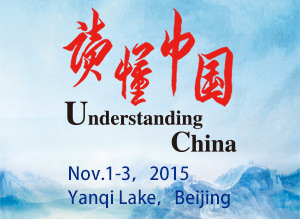
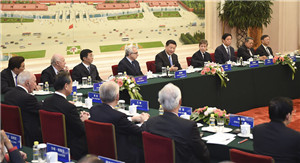
The 2nd "Understanding China" ConferenceOn November 1~3, 2015, the 2nd “Understanding China” Conference was held in Beijing Yanqi Lake International Conference Center. Zhang Gaoli, Vice Premier of the State Council, attended the opening ceremony.
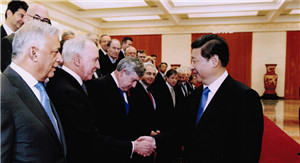
The 1st "Understanding China" ConferenceOn November 1~3, 2013, the 1st “Understanding China” Conference was held in Beijing, which was cosponsored by China Institute for Innovation & Development Strategy (CIIDS), Chinese People’s Institute of Foreign Affairs (CPIFA), and Berggruen Institute on Governance.
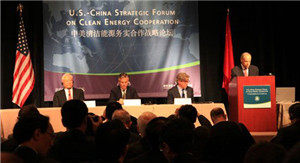
The 2nd U.S.-China Strategic Forum on Clean Energy CooperationWith the “Prospects for U.S.-China strategic cooperation in next decade” as its theme, the forum dwells on the implications of U.S.-China cooperation from the strategic perspective of coping with global challenges and maintaining world peace.
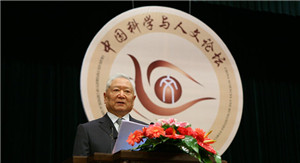
The China Sciences and Humanities ForumCo-initiated in April 2003 by renowned Chinese scientist Mr. Lu Yongxiang and influential political strategist Zhen Bijian, China Sciences and Humanities Forum was jointly hosted by Graduate University of Chinese Academy of Sciences (GUCAS) and the Higher Education Press.
-


